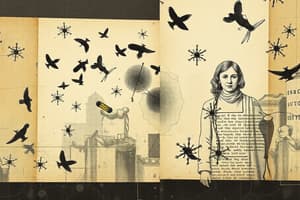Podcast
Questions and Answers
What are drugs that affect physiology in any manner called?
What are drugs that affect physiology in any manner called?
Drugs
What do chemotherapeutic agents do?
What do chemotherapeutic agents do?
Act against diseases
What are antimicrobial agents used for?
What are antimicrobial agents used for?
Treat infections
Who discovered penicillin?
Who discovered penicillin?
What are semisynthetics?
What are semisynthetics?
What is selective toxicity?
What is selective toxicity?
What is the most common action of antibacterial drugs?
What is the most common action of antibacterial drugs?
What do beta-lactams bind to?
What do beta-lactams bind to?
What is the function of Bacitracin?
What is the function of Bacitracin?
Semisynthetic drugs are more susceptible to deactivation than naturally occurring antibiotics.
Semisynthetic drugs are more susceptible to deactivation than naturally occurring antibiotics.
Vancomycin and cycloserine interfere with particular bridges that link _____ subunits in many Gram-positive bacteria.
Vancomycin and cycloserine interfere with particular bridges that link _____ subunits in many Gram-positive bacteria.
Flashcards are hidden until you start studying
Study Notes
History of Antimicrobial Agents
- Antimicrobial agents treat infections, derived from natural sources, chemically modified, or synthesized in labs
- Paul Ehrlich developed arsenic compounds to kill microbes
- Alexander Fleming discovered penicillin, a natural antibiotic released from the mold Penicillium
- Gerhard Domagk discovered sulfanilamide
- Selman Waksman coined the term "antibiotics" for antimicrobial agents naturally produced by organisms
- Semisynthetic antibiotics are chemically altered versions of naturally occurring ones, often leading to increased effectiveness, stability, and ease of administration
- Synthetic antimicrobials are entirely manufactured in laboratories
Mechanisms of Antimicrobial Action
- Antimicrobial drugs must exhibit selective toxicity, meaning they harm the infecting microbe without harming the host
- Most antimicrobial drugs target bacteria, with fewer effective drugs for eukaryotic infections and limited antiviral options
- Antimicrobial agents can target various cellular processes, including:
- Inhibition of Cell Wall Synthesis:
- Most common mechanism interrupts the formation of bacterial cell walls
- Beta-lactams (e.g., penicillin) are key examples, interfering with the cross-linking of NAM subunits, weakening the cell wall
- Semisynthetic beta-lactams are often more potent and stable
- Vancomycin, cycloserine, and bacitracin target different steps in the peptidoglycan synthesis pathway
- Isoniazid and ethambutol specifically disrupt mycolic acid formation in mycobacteria
- These inhibitors are effective only against actively growing cells as they don't affect existing peptidoglycan
- Inhibition of Cell Wall Synthesis:
Chemotherapeutic Agents: Modes of Action
- Antimicrobial action primarily targets bacterial cell walls, protein synthesis, nucleic acid synthesis, or metabolic pathways.
Studying That Suits You
Use AI to generate personalized quizzes and flashcards to suit your learning preferences.




